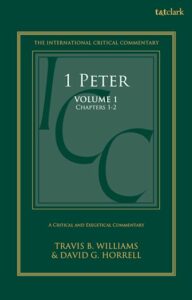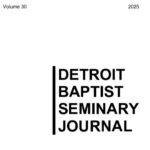Review of 1 Peter (ICC) by Williams and Horrell (Part 1)
Travis B. Williams and David G. Horrell have recently produced an expansive two-volume commentary on 1 Peter. Both volumes together stretch to just over 1,600 pages, covering 105 verses. The introduction alone is over 300 pages. It is one of the most well-researched commentaries currently available on 1 Peter. The bibliography at the end of the second volume is 150 pages with over 2,500 entries. Both men have produced an extensive library of academic work focusing on 1 Peter, culminating in this two-volume commentary. The International Critical Commentary intends to “bring together all the relevant aids to exegesis … to help the reader to understand the meaning” (from the General Editor’s Preface). The focus of the commentary aligns well with the authors’ credentials, as the authors are selected for “their scholarship and not for their adherence to any school of thought” (General Editor’s Preface). Conservative readers will likely enjoy the abundance of material on 1 Peter but often find the authors’ conclusions unsatisfactory. The authors’ primary purpose is to produce academic research rather than aid in sermon preparation, something any potential buyer should keep in mind.
The authors’ approach to the text-critical issues in 1 Peter is a key highlight of the commentary. In the first section of the introduction, they establish the text of 1 Peter by deviating from the traditional understanding of text criticism in light of the recent development of the Coherence-Based Genealogical Method or CBGM (pp. 4–5), offering readers a new perspective. The more recent edition of the Editio Critica Maior reflects the results of the CBGM on the Gospel of John and the Catholic Epistles, introducing variations from the previous critical edition of 1 Peter. Unlike the commentaries that precede them, Williams and Horrell seek to weigh individual witnesses within the text transmission to consider which readings most closely reflect the Ausgangstext or “initial text” (p. 5). Because the CBGM is relatively new, it’s difficult to evaluate the long-term benefits and acceptance of the system. Although it shows promise, Williams and Horrell occasionally deviate from its findings (e.g., in 1 Pet 5:1).
The authors have allowed their commitment to pseudonymous authorship to influence the dating of the letter. Williams and Horrell ultimately determine that the letter could have been written between AD 70 and 95 (p. 115). According to them, the “most important” clue as to the dating of the letter is the reference in 5:13 to Rome as “Babylon” (p. 112) because before AD 70, they argue there would have been no connection between Rome and Babylon in the minds of Christian readers (p. 113). That said, Babylon was a familiar city in the Old Testament. It could have stood in the readers’ minds as a city in moral opposition to God (so, e.g., Schreiner, 1 & 2 Peter and Jude, 291). Nothing the authors present will compel those committed to Petrine authorship to shift the dating of the letter to the 70s instead of the early 60s.
As mentioned, Williams and Horrell believe the letter was written pseudonymously. The first piece of evidence they cite is the dating of the letter. If Peter died in the mid-60s, he couldn’t write the letter in the 70s. Williams and Horrell take time to examine ancient sources and argue that Peter was martyred during the reign of Nero, who died in 68. The second piece of evidence the authors cite for pseudonymous authorship is the syntax of the letter. They claim the Greek is too polished for a Galilean fisherman to compose. Peter is described as “unschooled” or “uneducated” (ἀγράμματοί) in Acts 4:13. However, the reference in Acts 4:13 is more likely referring to rabbinical training (so, e.g., Miller and Murawski, 1 Peter, 30–31). In other words, Peter did not have formal theological training. Also, Peter could have employed a secretary to compose the letter. This cannot be definitively proven, but it is in the realm of possibility. Paul composed several letters this way.
Each section of the commentary begins with an initial bibliography for that section. Next, the authors give the Greek text, following their conclusions on the textual variants in the passage. The next section covers those textual variants. These textual portions are usually two pages or more. Should a question be raised regarding the text of 1 Peter, Williams and Horrell will likely have addressed it. Next, the authors begin a clause-by-clause exegetical analysis. This formatting helps locate the explanations of individual clauses within the larger unit. The authors conclude each unit with a summary section that contains their application and relevance for modern audiences. This last section is limited, usually only a few pages. Most of the commentary is given over to exegesis of the text.
Williams and Horrell follow modern scholarly consensus in identifying Gentiles as the most likely recipients, though they offer some caveats (pp. 211–212). In contrast to some critical scholarship, they suggest that 1 Peter was a unified letter (p. 29). They identify three major sections of the letter: (1) 1:13–2:10, (2) 2:11–4:11, and (3) 4:12–5:11 (pp. 36–37). However, they suggest that any attempt at identifying a structure is a scholarly exercise rather than “an act of ‘discovering’ what [the author] intended” (p. 36).
An important passage in the first volume is 1:18. Peter employs the verb ἐλυτρώθητε (“to redeem” or “to set free”) to describe the readers’ present situation. Williams and Horrell suggest two possible meanings. In Greek documents, the term describes the release of a prisoner or a slave in exchange for payment (p. 508). However, in the LXX, the term is used with God as the subject and means to rescue from an oppressive situation, reflected in the deliverance of the Israelites from Egypt and Babylonian captivity (p. 509). The authors say little regarding the debate of substitutionary versus ransom atonement views even after admitting this passage’s importance for that discussion. Instead, they believe that the letter’s author “melds together different traditions and re-interprets them in light of a Christian perspective” (509).
The authors’ theological discussions are a weakness that pervades the commentary. Often, discussions of important issues are left unaddressed. For example, there is minimal discussion of the resurrection in their comments on 1:21 (pp. 532–3). The authors fail to contribute meaningfully to Christological discussions despite admitting that 1:18–1:21 is a “christologically rich passage” (p. 507). Furthermore, they do not directly state but imply that the author of 1 Peter denies the divinity of Jesus (533).
Despite these flaws, which are not insignificant, the newest edition to the ICC series stands above the current literature on 1 Peter in terms of research and textual analysis. Williams and Horrell have provided a monumental service to Petrine scholars. This will be the English commentary to interact with for academics who want to follow current studies on 1 Peter. This set would also be a good addition to a pastor’s library for those wishing to do more academic-focused research. Commentaries on 1 Peter from Schreiner and Jobes (both now in second editions) will, I think, serve sermon preparation better and should be purchased first. Another drawback is the price of the commentary. At around $100 per volume, it may be out of reach for many men in pastoral ministry.
Read Part 2 here.



